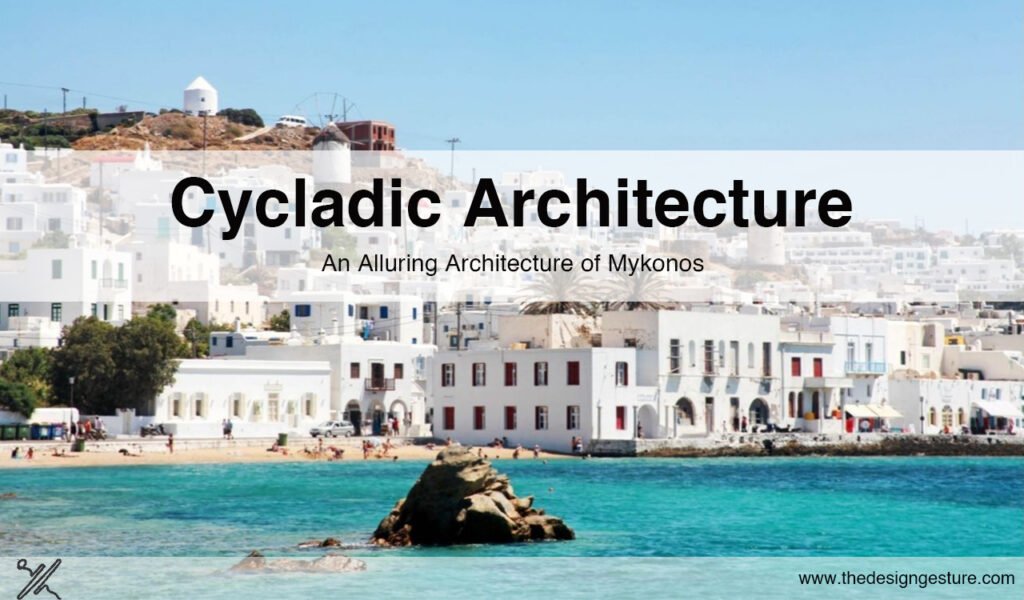White as the sun, blue as the sea, and enthralling as legends from the past. Mykonos, like the rest of the Cycladic islands, has a distinct architectural style based on simple materials and lines. Its structures were built to meet the demands of the original occupants, but now they blend seamlessly with the Aegean Sea’s natural beauty.
Mykonos is perhaps the most cosmopolitan of the Cyclades islands and one of the most beautiful examples of ancient Cycladic architecture. Classical and cubic houses featuring flat roofs, wooden coloured doors, and windows generate a distinctive ambiance that reflects the primary aspects of the traditional design, which is now famous worldwide. Despite its expansion as a tourist destination, Mykonos has a distinct Cycladic identity.
Mykonos, as the most visited island in the Cyclades, is credited with popularizing Cycladic architecture around the globe. Mykonian architecture is a blend of Greek traditional and Venetian forms, with a cubic and basic aesthetic.
Table of Contents
What is Cycladic Architecture?
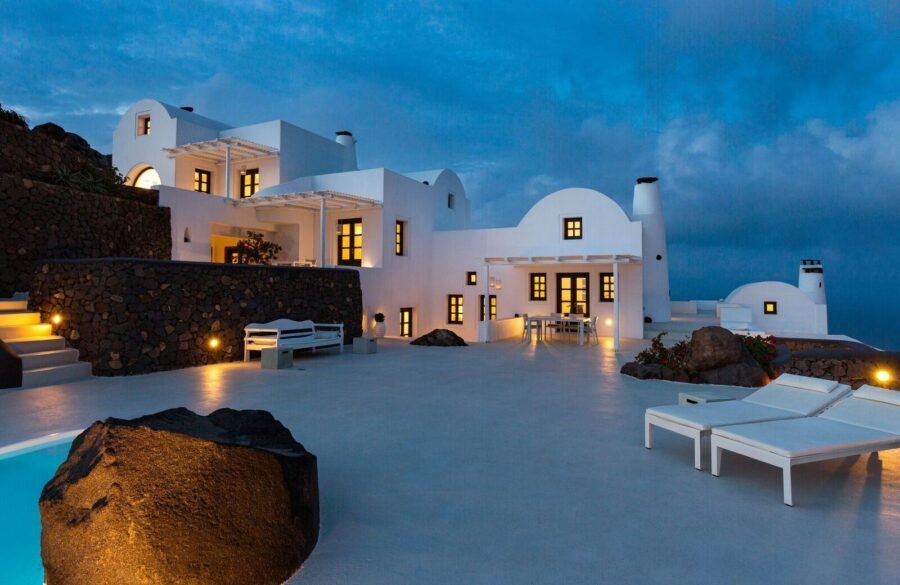
The remarkable Cycladic architecture interior that distinguishes the islands that make up this wonderful Aegean archipelago situated between Athens and Crete is modest and austere, but completely gorgeous and unique. Each of the Cyclades islands has its own charm and personality, from popular Mykonos and postcard-perfect Santorini to Venetian-flavoured Naxos and the peaceful, lesser-known islands of Amorgos and Sifnos.
The native architecture, which gleams in beautiful whites and blues under the magnificent Mediterranean sun, is dominated by flat roofs, cubic shapes, and dazzling whitewashed walls. Interestingly, the majority of these one-of-a-kind towns were created in an unintentional manner with inexpensive resources.
The Cycladic house style provides inspiration in constructing some of today’s most stunning settings, despite the fact that art and aesthetics have never been a priority for the islands’ residents, with the main objective being to meet the people’s requirements.
Where White Buildings Meet Vibrant Gardens
Some of the most distinctive features of cyclades architecture are the completely white buildings with vibrant gardens, stone-paved roads, and light blue churches. The majority of the structures are extremely basic and minimalistic in design, as well as being built relatively far from the coast and with few windows.
That is part of the defense against pirates, which used to be a serious issue for the islanders, and it is also why certain islands’ residences and villages are surrounded by strong stone walls.
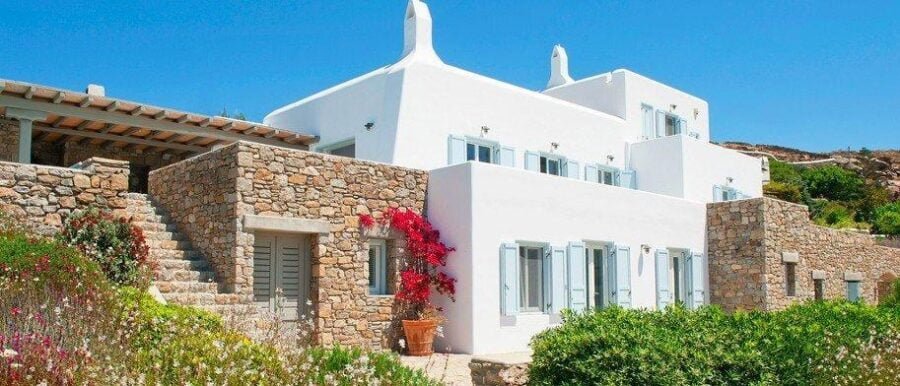
While they are erected southeast, the majority of the structures have only one level and their timbers never exceed 3 meters. The walls are 60-80cm wide, and the windows are modest, with only one on the north side, as previously described. People developed these characteristics simply because they wanted to maintain desirable temperatures throughout the year, chilly in the summer and warmer in the winter.
White and Blue: The Iconic Colors of Cycladic Architecture
White certainly plays a significant part in Cycladic architecture for the same reason. Apart from the apparent fact that white and blue are the signature colours of Greece and appear on the Greek flag in fact, Greek Prime Minister Loannis Metaxas ordered all Cycladic houses to be painted with those colours in 1936 to represent the white foam of the Aegean sea and the unique blue of the Greek sky, white is also considered the least solar absorbent, resulting in a cool temperature inside the houses during the summer.
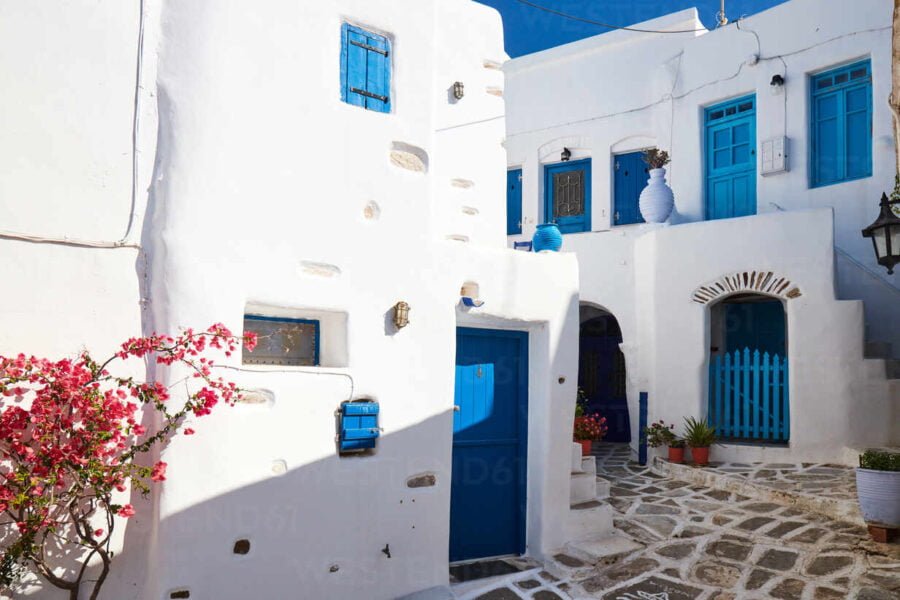
White is also considered to be the least solar absorbent, thus maintaining Churches are inextricably linked to the Cycladic history and are constructed in the same way. They’re almost entirely white, symbolising purity, with blue domes on occasion, and their beauty is undeniable!
Windmills and Architectural Diversity in the Cyclades
Even while there is a general concept running through all of the Cycladic structures, each island has its own distinct characteristics based on its demands. On the highlands of Mykonos, Ios, and Paros, for example, some windmills that were once used to crush grain can still be found. Even if they are no longer useful, they are still a stunning sight to behold, and making a visit would be an unforgettable experience.

Mykonian Architecture Explained
When a tourist asks for directions, the locals joke that they’ll find it next to the white house with blue windows. Of course, this suggestion is useless because nearly every house on the island has the same design. The ‘character’ of Mykonos is made up of cubic whitewashed cottages without roofs, blue shutters, churches with colourful domes, stunning windmills, and innumerable narrow alleyways.
A Blend of History and Inspiration
Mykonos used to be surrounded by castles to protect themselves from robbers and pirates. Mykonos has some impressive architecture to show off, with alleys narrow enough to dissuade pirates from raiding the cities and small dwellings placed one atop the other for the same reason.
Small buildings were compelled to be built due to a lack of essential building materials at the time, and their cubic shape and characteristic white hue were a response to the unusual weather circumstances.
The dwellings were shielded from the fierce Meltemi winds by the square forms. White-washed walls protected against the blazing temperatures by reducing heat absorption while allowing the eye to follow the undulations of the surfaces and see the shapes as a whole. All of this occurs in Mykonos Town, or Chora as it is known among the locals.
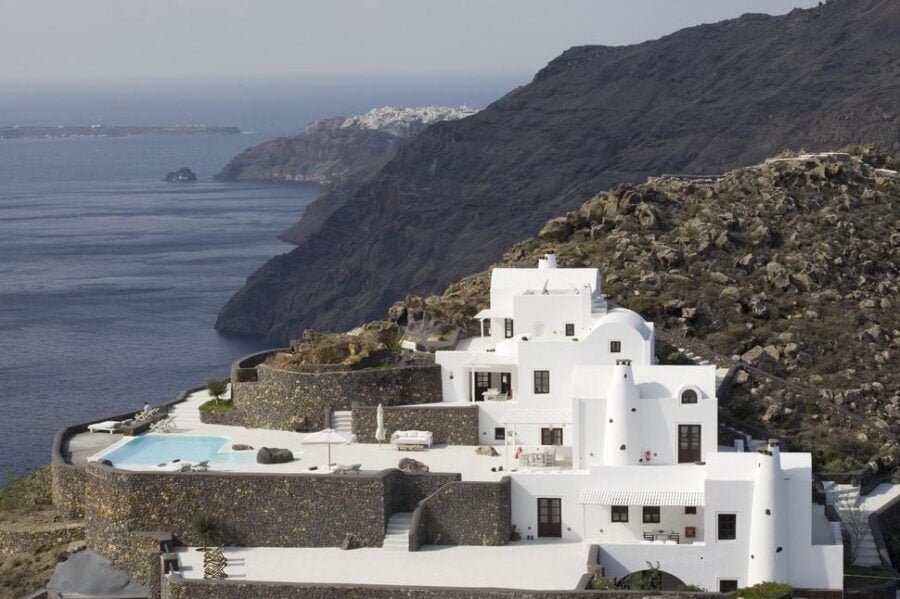
Mykonos in the countryside has a unique perspective to offer. Simplistic, bare cottages with cell-like accommodations and dappled patios ensconced amidst huge fields, each adorned with pens for farm animals, a well, a water cistern, a winepress, a wood-fired oven, and in a few instances, a beautiful church, all built with astounding, in-depth expertise of the principle of space.
Where every little cube is so accurately centered and brilliantly placed in just the right part of the surrounding field, achieving what is known The plan was to build a house large enough to fit in while still owning a field that stretched as far as the eye could see.
It appears that these individuals have captured the essence of life, where wealth is not measured by the size of one’s home. Instead, people’s riches came from basic, daily things and the pleasure of appreciating what Mother Nature had to provide in abundance in this Mediterranean location.
Adapting to Nature: The Evolution of Mykonian Architecture
The residents’ distinct demands influenced the evolution of Mykonian architecture. One of them has been shielding from the island’s unique weather, which included practically daily northern winds and scorching summer sun. Building the dwelling facing south was a simple but clever solution for the winds. The white tint reflects the sun’s rays, keeping the interior of the home cool.
The houses have to be modest and simple due to a lack of building materials on the island. The cubic shape is the most efficient approach to save the materials that are so much needed. The Mykonians’ ingenuity and poverty combined to produce the remarkable architecture we enjoy today.
Harmony with Nature: Mykonos’ Architectural Brilliance
Many architects attempted to impose their perspective on Mykonos’ powerful scenery and manipulate nature to their benefit. They were a colossal failure. Those who were able to adapt to the island’s natural pre-existing landscape circumstances and design structures that were completely in tune with the island’s beating heart and general vibe were able to taste what basic intelligence implies.
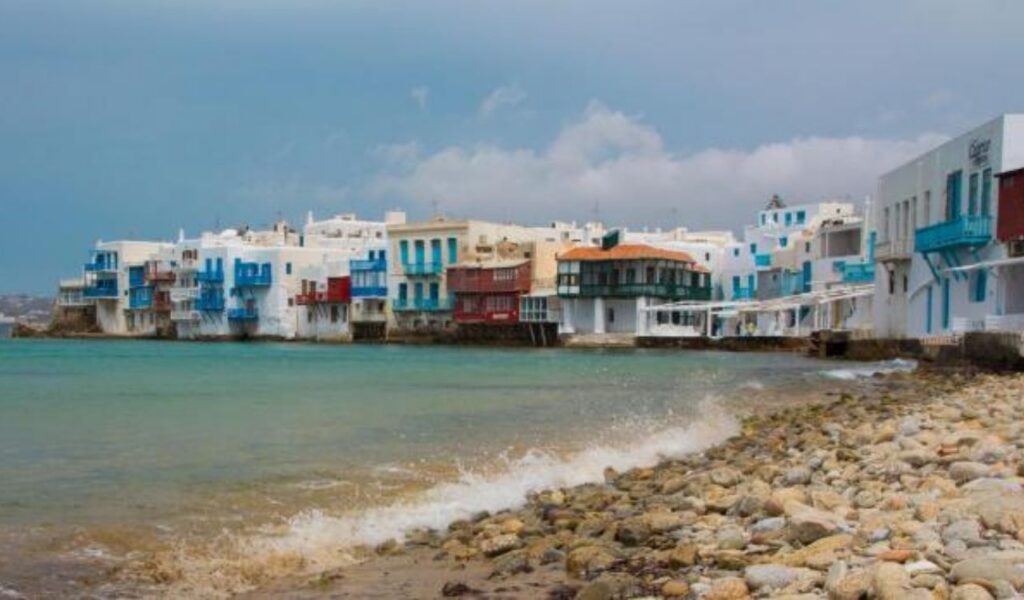
Everything in this place has been meticulously planned. Consider how the Mykonians protected their homes from the harsh northern winds by positioning them with their backs to the north. This means that on a windy day, you may stand on the front veranda of an ancient house and be completely safe!
We couldn’t overlook Paraportiani when it came to distinctiveness. The two-level cluster of five churches, which has been designated as an important monument for its one-of-a-kind architecture, is a unique landmark of the island.

It was named after the northwest gate of Mykonos’ Middle Age fortification, which translates to “paraporti” in Greek. The modest, arched bell tower on the eastern face aesthetically completes this unique complex and speaks clearly of the architecture of the Cycladic castles.
Windmills, on the other hand, were formerly a major contributor to the island’s economic success. Presently, it is a well-photographed Mykonos icon, a proud memory of happier older times.
The Eco-Friendly Structures of Mykonos
The structures on Mykonos Island fit in harmoniously with the surrounding landscape, demonstrating the utmost regard for the soil while remaining completely environmentally friendly. Seaweed and sand were often used to insulate flat roofs. Humidity and heat loads are reduced via small openings on the northern sides of the homes. Every classic structure has smooth asymmetrical curves on the corners for a reason.
Cooling is achieved by using shady regions with lush flora and stone barriers outside. Nothing about the distribution of the homes’ volumes in relation to the direction of the winds and their exposure to them is a coincidence. Different heights, recesses, inner yards, and different forms of semi-open spaces, such as alcoves and verandas, all play an important role.
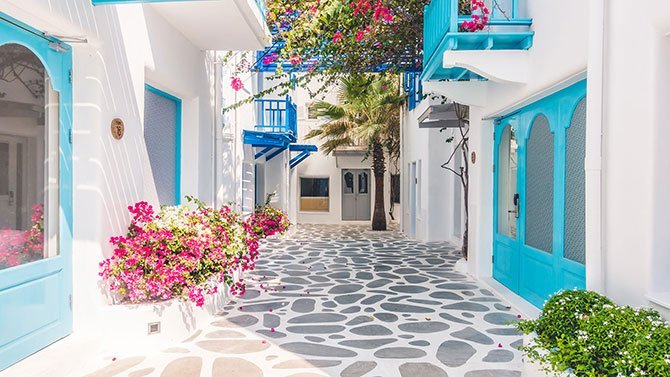
However, in more recent years, something fresh and wonderful occurred when the architectural committee voted to allow non-white dwellings to be built under very special circumstances.
The committee gave the go light to construct non-white hilltop mansions after architect Dimitris Mantikas provided them with studies proving that a huge white house on a hill would detract from its surroundings and appear pretentious (i.e. built from rock, which blend in so perfectly that they almost disappear into the hill). The same architect developed and built the double walls that preserved the ancient Cycladic style and architecture by bringing much of the shapes of the old farmhouses.
Today’s Makeover
Much has changed and evolved, pushed by the requirements of the day, from those long ago times to the stunning homes with revitalising private pools perched atop every little slope. New components have been introduced to what we now refer to as typical Cycladic character over the years. The house was turned from a place to meet the fundamental necessities of individuals who lived there to a vessel that served opulent vacations.
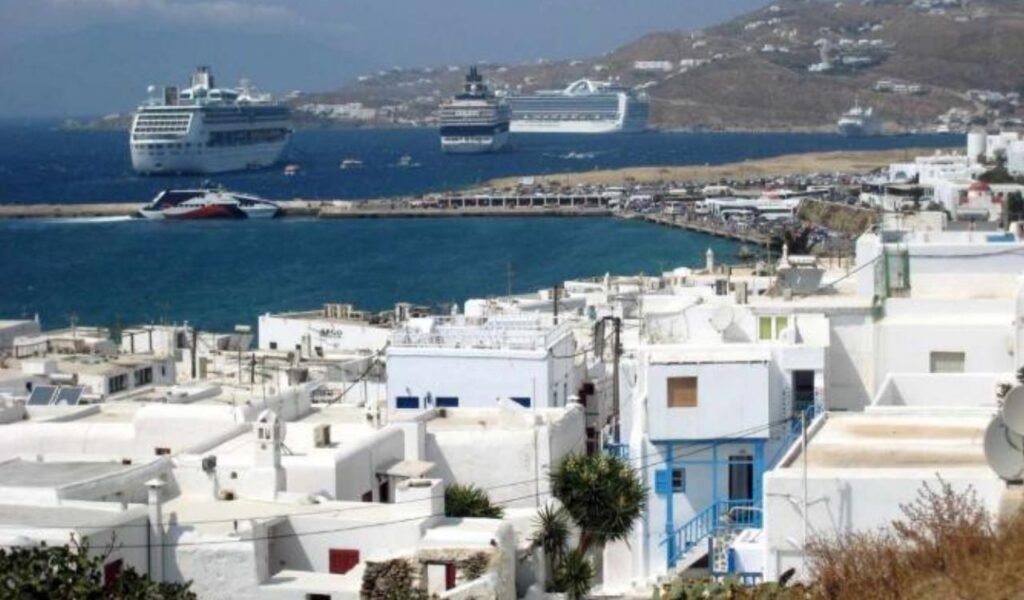
We now see buildings made with modern materials that architects of the past would never have imagined. The location known as Little Venice is located between Alefkadra and the centre of the old Castle. It is not typical of Cycladic architecture, but it is a truly unique corner of Mykonos. There are brilliant colours painted on the sea-washed (literally!) dwellings, as well as wooden open-air balconies.
Mykonos, though, has maintained its allure and individuality. In fact, since 2005, the island has been legally designated as a place of natural, peculiar beauty, with dry earth patches, round boulders, and small chapels with red-arched roofs strewn about like a dreamland.
Overall, despite the fact that Mykonos is an island of loud displays of wealth, it has managed to preserve ancient Cycladic architecture principles and shapes free of modernity and excess because to urban planning rules and architects’ respect for the land and its past.
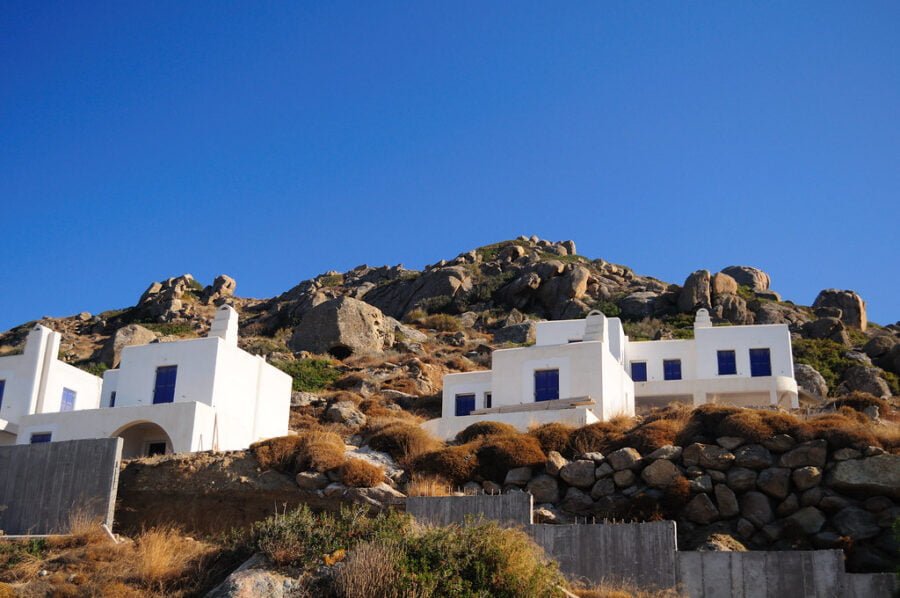
In areas like Portes and Lino, the colourful people that go to Mykonos every summer may still see the ruins of the once majestic castles that once stood like restless guardians over the Mykonians.
The whitish, flat-roofed, cubic buildings, with their flowery balconies and wooden windows and doors painted in various hues of Aegean blue, like a cluster of white grapes and greet visitors with the warmth of the scorching Mediterranean sun and an enchanted network of paved small alleyways, crystal clear seas, and golden beaches.
FAQs
Q. What is Cycladic architecture?
A. This architecture refers to the traditional building style found on the Cyclades islands in Greece. Cyclades houses are identified by its simplicity, use of basic materials, and unique aesthetic, with buildings often featuring whitewashed walls, flat roofs, and minimalistic design elements.
Q. What are some key features of ancient Cycladic architecture?
A. Ancient architecture are very popular for its cubic shapes, flat roofs, and whitewashed walls. These features were designed to help buildings withstand the island’s very harsh and cruel climate, including strong winds and intense sunlight.
Q. How does Cycladic architecture influence interior design?
A. Cycladic interior design often reflects the same principles as the exterior, with a focus on simplicity, minimalism, and natural materials. Interiors are typically bright and airy, with whitewashed walls and blue accents that mimic the colors of the sea and sky.
Q. What are some examples of Cycladic house design?
A. Cycladic houses are typically small and simple, with a focus on functionality and practicality. They often feature cubic shapes, flat roofs, and small windows to protect against the elements. Houses are usually painted white to reflect the sun’s heat and keep interiors cool.
Q. How does Cycladic architecture differ from other architectural styles?
A. Architecture cycladique is unique in its simplicity and minimalism, which is a result of the islands’ limited resources and harsh climate. Unlike more ornate architectural styles, Cycladic architecture focuses on practicality and efficiency, with an emphasis on blending into the natural landscape.
Q. What is the significance of architecture in Mykonos and the Cyclades?
A. Architecture in Mykonos and the Cyclades is not just about aesthetics; it also plays a practical role in protecting against the elements. in architecture Mykonos the whitewashed walls and flat roofs of Cycladic buildings help keep interiors cool in the summer and protect against the wind and rain.

